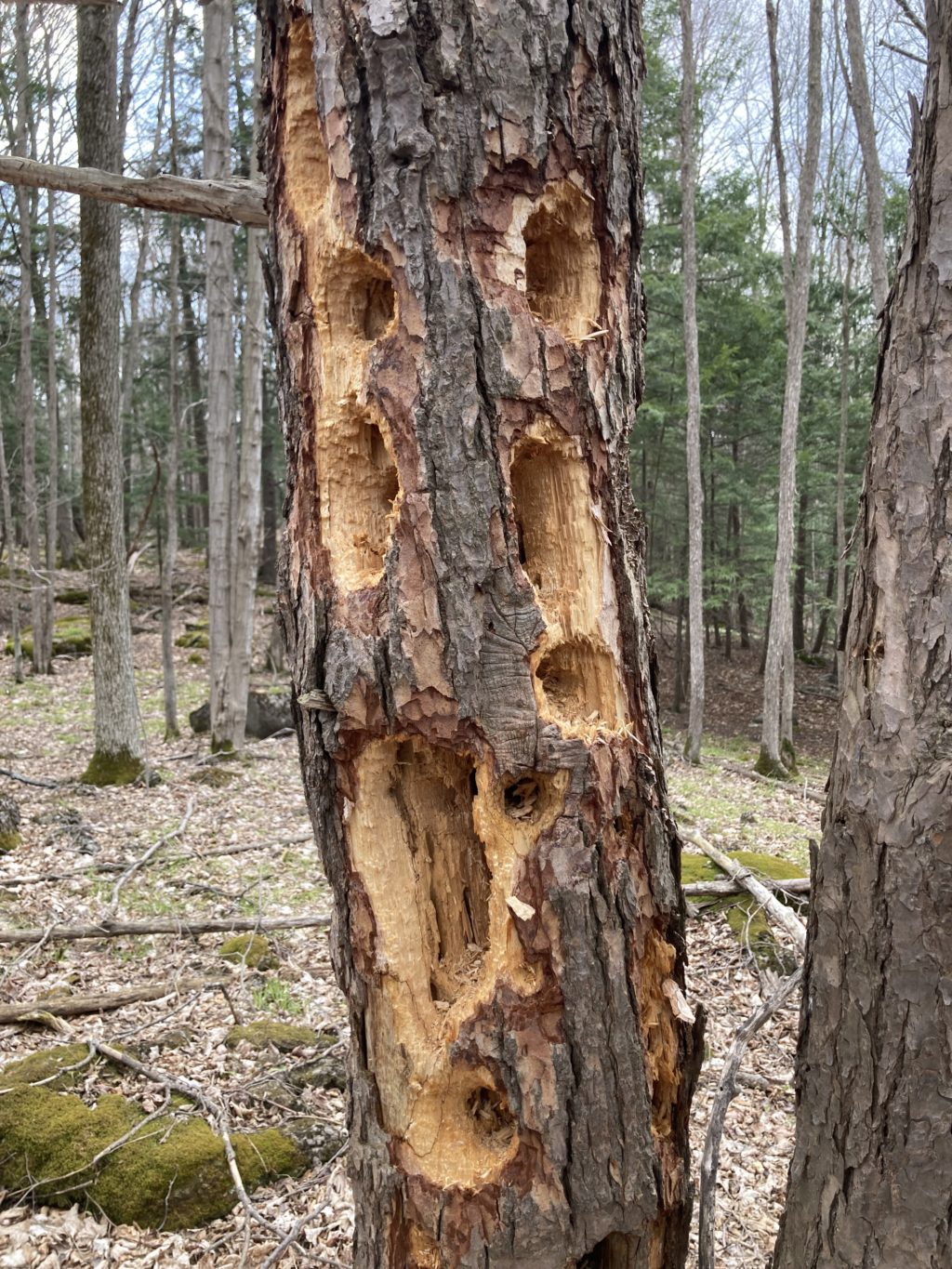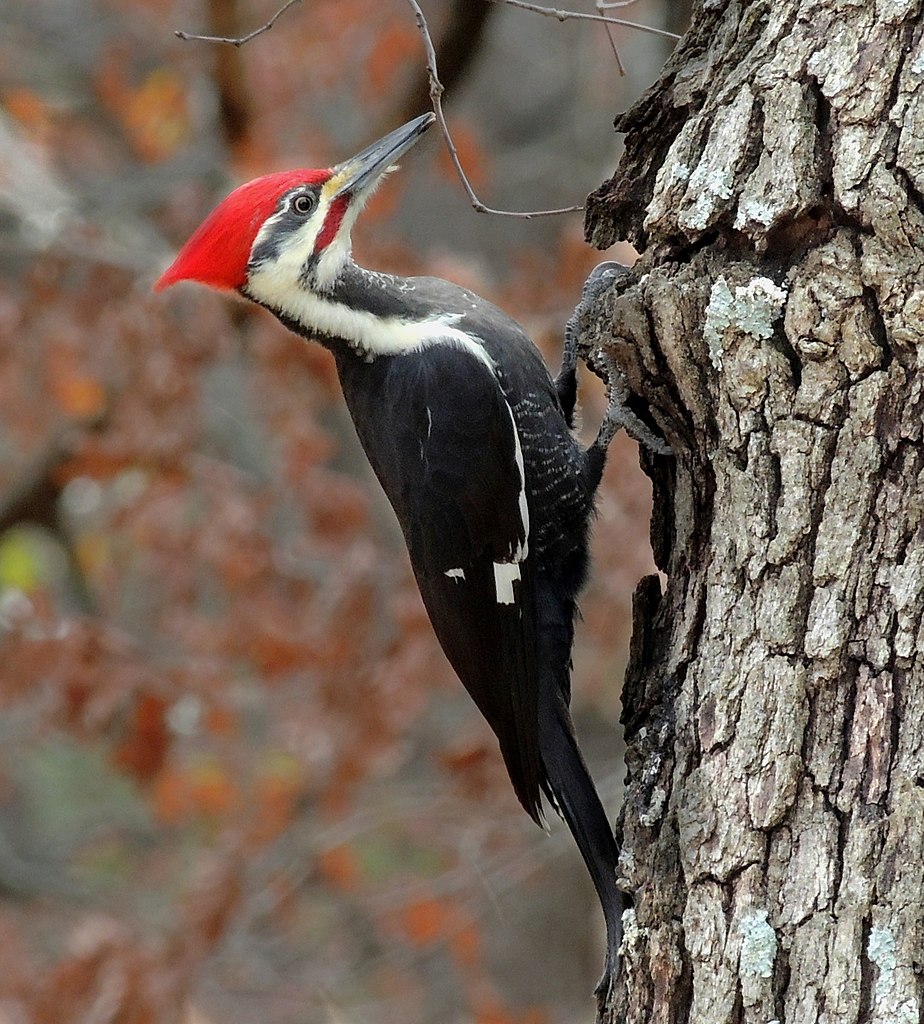Almanac: Hammerhead

Holes created by one of the largest and most striking forest birds in our area. Photo: Stephen Braun
The other day I came across a dead tree riddled with holes, some quite large and roughly rectangular. They were the distinctive signatures of Pileated Woodpeckers, our largest and most striking woodpecker, which sport flaming red crests and vivid black-and-white stripes across their faces.
Pileateds are not that rare—I see them fairly often pounding away at a half-dead tree in my back yard. I hear them more frequently than I lay eyes on them because their call sounds, to me, like a jungle monkey laughing from the treetops. Their impressive excavations can be a foot or more long and go deep inside the wood as the birds pursue carpenter ants (their primary food) or other delicious morsels such as beetle larvae, termites, and other insects. Like other woodpeckers, Pileateds have incredibly extensible, worm-like tongues that have hard, barbed ends ideal for prying out their prey.

I’m always mildly astonished when I see (or hear) woodpeckers banging away for their lunch. These days, with so much attention paid to protecting our heads with helmets and preventing sports-related head injuries, it’s incredible to me that these birds can use their heads as a hammer and chisel all day long without turning their brains to pudding. Woodpeckers probably don’t even get headaches, although it’s hard to resist the temptation, watching one of these birds pause after a bout of jackhammering, to imagine that they are a little dazed or cross-eyed from the effort. In fact, they’re probably perfectly clear-headed. First, their brains are not all that massive, so they don’t pick up that much momentum from the motion of the head. But more importantly, woodpecker brains are wrapped in a kind of shock-absorbing cocoon. The brain is enclosed in a tough, fluid-filled sack. The brain can thus rock slightly back and forth in this sack without hitting the wall of the skull.
When hammering into wood, Pileateds use their long neck to pull far back from the tree, then make powerful strikes with their heavy bill, pulling with their feet to increase the strength of the blow. The sound is often a heavy thunk, and large chips of wood collect on the ground below. Pileateds dig holes to create nests, as well as to search for food. Typically, the male of a couple (they’re usually monogamous) begins excavating the nest cavity and does most of the work, but the female contributes, particularly as the hole nears completion by chipping away from the inside. It takes 3-6 weeks to excavate a nest, and nests are rarely reused.
Although dead trees may not be pretty, you might consider leaving a dead or dying tree alone if it’s not a hazard, to attract Pileateds, as well as other woodpeckers, nuthatches, and other insect-loving birds, to forage, roost, or even nest in them.
As handsome and impressive as Pileated Woodpeckers are, they are smaller and arguably less striking than a related species dubbed the “Good Lord Bird” and widely believed, until last week, to be extinct: the Ivory-billed Woodpecker. A team of researchers recently submitted for peer review a paper detailing multiple lines of evidence acquired over the past decade suggesting that the Ivory-billed Woodpecker is not, in fact, extinct. The last widely accepted sighting of this species was in 1944, but more than 200 sightings have been reported since then, some by ornithologists or other professionals. Now, the authors claim to have repeatedly seen and photographed the elusive creatures in an unidentified location in Louisiana.
The photos and other evidence presented in the recent paper are not as crisp and unequivocal as anyone would like, but the totality of the evidence is impressive. The survival of this species in the face of habitat destruction, hunters, and (in the early decades of the 20th century) collectors would raise a cheer from more than just bird lovers. It would be a wonderful symbol of nature’s resilience, and, also, a reminder that we humans do not, in fact, know everything.
Almanac is a regular Indy column of observations, musings, and occasional harangues related to the woods, waters, mountains, and skies of the Pioneer Valley. Please feel free to comment on posts and add your own experiences or observations.

1 thought on “Almanac: Hammerhead”